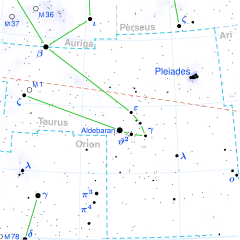astro.wikisort.org - Star
Upsilon Tauri (υ Tauri) is a solitary,[11] white-hued star in the zodiac constellation of Taurus, and is a member of the Hyades star cluster.[8] It is faintly visible to the naked eye with an apparent visual magnitude of +4.3. Based upon an annual parallax shift of 21.21 mas seen from Earth, it is around 154 light years from the Sun.
 | |
| Observation data Epoch J2000.0 Equinox J2000.0 (ICRS) | |
|---|---|
| Constellation | Taurus |
| Right ascension | 04h 26m 18.46368s[1] |
| Declination | +22° 48′ 48.8885″[1] |
| Apparent magnitude (V) | 4.28 – 4.31[2] |
| Characteristics | |
| Spectral type | A8 Vn[3] |
| U−B color index | +0.14[4] |
| B−V color index | +0.25[4] |
| Variable type | δ Scuti[2] |
| Astrometry | |
| Radial velocity (Rv) | 32.2±1.1[5] km/s |
| Proper motion (μ) | RA: +108.81[1] mas/yr Dec.: −46.80[1] mas/yr |
| Parallax (π) | 21.21 ± 0.25 mas[1] |
| Distance | 154 ± 2 ly (47.1 ± 0.6 pc) |
| Absolute magnitude (MV) | +0.91[6] |
| Details | |
| Mass | 1.55[7] M☉ |
| Radius | 1.803[8] R☉ |
| Luminosity | 32.5[9] L☉ |
| Surface gravity (log g) | 3.50[7] cgs |
| Temperature | 7,398±252[7] K |
| Rotation | 0.415 d[8] |
| Rotational velocity (v sin i) | 243[3] km/s |
| Age | 827[7] Myr |
| Other designations | |
| Database references | |
| SIMBAD | data |
Properties
![A light curve for Upsilon Tauri, plotted from TESS data[12]](http://upload.wikimedia.org/wikipedia/commons/thumb/2/20/UpsilonTauLightCurve.png/220px-UpsilonTauLightCurve.png)
This is an A-type main sequence star with a stellar classification of A8 Vn.[3] It is classified as a Delta Scuti type variable star and its brightness varies from magnitude +4.28 to +4.31 with a period of 3.56 hours.[2] At an estimated age of 827 million years,[7] it is spinning rapidly with a rotation period of just 0.415 days.[8] This is giving the star an oblate shape with an equatorial bulge that is 9% larger than the polar radius.[13]
Occasionally this star system shares the Bayer designation υ Tauri with 72 Tauri, which is separated from it by 0.29° in the sky.[14]
Naming
With φ, κ1, κ2 and χ, it composed the Arabic were the Arabs' Al Kalbain, the Two Dogs.[15] According to the catalogue of stars in the Technical Memorandum 33-507 - A Reduced Star Catalog Containing 537 Named Stars, Al Kalbain were the title for five stars : φ as Alkalbain I, χ as Alkalbain II, κ1 as Alkalbain III, κ2 as Alkalbain IV and this star (υ) as Alkalbain V.[16]
References
- van Leeuwen, F. (2007), "Validation of the new Hipparcos reduction", Astronomy and Astrophysics, 474 (2): 653–664, arXiv:0708.1752, Bibcode:2007A&A...474..653V, doi:10.1051/0004-6361:20078357, S2CID 18759600.
- Samus, N. N.; et al. (2017), "General Catalogue of Variable Stars", Astronomy Reports, 5.1, 61 (1): 80–88, Bibcode:2017ARep...61...80S, doi:10.1134/S1063772917010085, S2CID 125853869.
- Royer, F.; et al. (February 2007), "Rotational velocities of A-type stars. III. Velocity distributions", Astronomy and Astrophysics, 463 (2): 671–682, arXiv:astro-ph/0610785, Bibcode:2007A&A...463..671R, doi:10.1051/0004-6361:20065224, S2CID 18475298.
- Danziger, I. J.; Dickens, R. J. (July 1967), "Spectrophotometry of New Short-Period Variable Stars", Astrophysical Journal, 149: 55, Bibcode:1967ApJ...149...55D, doi:10.1086/149231.
- de Bruijne, J. H. J.; Eilers, A.-C. (October 2012), "Radial velocities for the HIPPARCOS-Gaia Hundred-Thousand-Proper-Motion project", Astronomy & Astrophysics, 546: 14, arXiv:1208.3048, Bibcode:2012A&A...546A..61D, doi:10.1051/0004-6361/201219219, S2CID 59451347, A61.
- Anderson, E.; Francis, Ch. (2012), "XHIP: An extended hipparcos compilation", Astronomy Letters, 38 (5): 331, arXiv:1108.4971, Bibcode:2012AstL...38..331A, doi:10.1134/S1063773712050015, S2CID 119257644.
- David, Trevor J.; Hillenbrand, Lynne A. (2015), "The Ages of Early-Type Stars: Strömgren Photometric Methods Calibrated, Validated, Tested, and Applied to Hosts and Prospective Hosts of Directly Imaged Exoplanets", The Astrophysical Journal, 804 (2): 146, arXiv:1501.03154, Bibcode:2015ApJ...804..146D, doi:10.1088/0004-637X/804/2/146, S2CID 33401607.
- van Saders, Jennifer L.; Pinsonneault, Marc H. (October 2013), "Fast Star, Slow Star; Old Star, Young Star: Subgiant Rotation as a Population and Stellar Physics Diagnostic", The Astrophysical Journal, 776 (2): 20, arXiv:1306.3701, Bibcode:2013ApJ...776...67V, doi:10.1088/0004-637X/776/2/67, S2CID 119097746, 67.
- McDonald, I.; et al. (2012), "Fundamental Parameters and Infrared Excesses of Hipparcos Stars", Monthly Notices of the Royal Astronomical Society, 427 (1): 343–57, arXiv:1208.2037, Bibcode:2012MNRAS.427..343M, doi:10.1111/j.1365-2966.2012.21873.x, S2CID 118665352.
- "ups Tau", SIMBAD, Centre de données astronomiques de Strasbourg, retrieved 2017-08-05.
- Eggleton, P. P.; Tokovinin, A. A. (September 2008), "A catalogue of multiplicity among bright stellar systems", Monthly Notices of the Royal Astronomical Society, 389 (2): 869–879, arXiv:0806.2878, Bibcode:2008MNRAS.389..869E, doi:10.1111/j.1365-2966.2008.13596.x, S2CID 14878976.
- MAST: Barbara A. Mikulski Archive for Space Telescopes, Space Telescope Science Institute, retrieved 8 December 2021.
- van Belle, Gerard T. (March 2012), "Interferometric observations of rapidly rotating stars", The Astronomy and Astrophysics Review, 20 (1): 51, arXiv:1204.2572, Bibcode:2012A&ARv..20...51V, doi:10.1007/s00159-012-0051-2, S2CID 119273474.
- Hoffleit, D.; Jaschek, C. (1991), The Bright Star Catalogue, New Haven: Yale University Observatory, Bibcode:1991bsc..book.....H.
- Allen, Richard Hinckley (1899), Star-Names and Their Meanings, New York: G. E. Stechert, p. 413
- Rhoads, Jack W. (November 15, 1971), Technical Memorandum 33-507-A Reduced Star Catalog Containing 537 Named Stars (PDF), Jet Propulsion Laboratory, California Institute of Technology.
Другой контент может иметь иную лицензию. Перед использованием материалов сайта WikiSort.org внимательно изучите правила лицензирования конкретных элементов наполнения сайта.
WikiSort.org - проект по пересортировке и дополнению контента Википедии